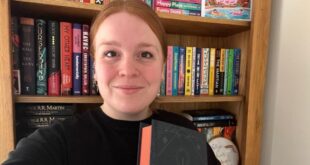
Ken Follett, renowned for his thrillers and historical fiction, has built a career as one of modern literature’s most read and revered writers.
With over 40 novels to his name – celebrated for their shocking narratives, rich character development, and meticulously researched scenarios – his work has sold more than 195 million copies worldwide.
After making the move from being a journalist and publisher – which allowed him to write books on the side – to full-time author, thanks to the success of the 1978 thriller Eye of the Needle, Follett went on to cement his place in best-seller lists with every project he released since.
He ventured into nonfiction with the 1989 historical novel The Pillars of the Earth, an epic that was eventually followed by three sequels, a prequel, and a television series adaptation – by Ridley Scott, no less.
In 2023, he listed his all-time favourite fiction reads for The Week, including titles of suspense, science fiction, and classic literature.
Here are Ken Follett’s favourite fiction books of all time:
Orley Farm by Anthony Trollope
Orley Farm revolves around the legal and moral complexities of a will and codicil, centered around Lady Mason, who is accused of forging a document to secure her son’s inheritance.
The story unfolds as a tenant challenges the inheritance, leading to an investigation and court battles – exploring themes of guilt, justice, and familial loyalty.
“Trollope’s first success, and a masterpiece of construction. It’s a complex courtroom drama, though we don’t get to court until late in the book”, said Follett. “As the case unfolds, Trollope describes the effect of each development on each of several characters. The suspense is terrific as the net slowly tightens around the guilty party.”
Dune by Frank Herbert
In Frank Herbert’s Dune – a title that is now also a box-office hit film series of the 2020s -, the story follows young Paul Atreides, heir to House Atreides, as he navigates the political and ecological complexities of the desert planet Arrakis, the sole source of the valuable spice melange.
Betrayed by powerful rivals, Paul’s journey leads him to embrace his destiny as Muad’Dib, a messianic figure who unites the native Fremen people and ultimately shapes the fate of the known universe.
Follett commented on it: “A magnificent science fiction blockbuster. The story takes place mostly on a brilliantly imagined desert planet in a universe of tyranny and violence. The ecology of the planet is startling but credible. Multiple storylines are interwoven and come together shockingly but in a deeply satisfying way.”
Cousin Bette by Honoré de Balzac
A story of revenge and social mobility set in 19th-century Paris, Cousin Bette centers around the character of Lisbeth Fischer – the title character – who plots the downfall of her wealthy, condescending relatives, the Hulots, after feeling overlooked.
Driven by a mixture of resentment and ambition, Cousin Bette manipulates and orchestrates the destruction of their lives, exposing their hypocrisy and moral decay.
“A fascinatingly horrible villainess, a cast of mostly unscrupulous Paris schemers, several charming prostitutes, and a very few decent people who mostly come to a sad end”, said Follett. “This is a vicious tale of clever, remorseless revenge, served very cold. I love Balzac because he doesn’t flinch from how cruel the world is.”
Bleak House by Charles Dickens
Charles Dickens’ 14th novel satirizes the British legal system, particularly the Court of Chancery, through the story of a long-running lawsuit, Jarndyce and Jarndyce, which consumes the lives and fortunes of those involved.
The story follows Esther Summerson, a young woman raised by her aunt, as she navigates the complexities of the legal case and her own personal relationships, including with Lady Dedlock and John Jarndyce.
Follett admitted he “dithered over which Dickens to choose because I love so many (but not all)”, but ended up deciding on this one, adding: “This is one of his best. The plot is deep, the entanglements complex, and the big scenes wonderfully melodramatic. But, as always, we remember the characters: haughty Lady Dedlock, foolish Richard Carstone, sponging Harold Skimpole, the sly lawyer Tulkinghorn, and Inspector Bucket of the Detective Branch”.
Live and Let Die by Ian Fleming
In Ian Fleming’s James Bond instalment Live and Let Die, 007 investigates a crime network led by the enigmatic Mr. Big, who’s involved in smuggling British pirate treasure and funneling the proceeds to the KGB.
Bond travels from Harlem to Jamaica and enlists the help of his friend Felix Leiter and Solitaire, a Creole fortune teller, to expose Mr. Big’s operations and reclaim the stolen treasure.
“I read this when I was 12, and re-read it a few weeks ago to see whether it was as good as I remembered. It was”, commented Follett. “The opening line is so alluring: ‘There are moments of great luxury in the life of a secret agent.’ As well as luxury, we get three terrific action scenes, the last mostly underwater.”
The House of Doors by Tan Twan Eng
He closed off the list with The House of Doors by Tan Twan Eng, a historical novel set in 1921 Penang that explores the themes of love, betrayal, and the power of storytelling through the lens of fictionalized encounters with writer W. Somerset Maugham.
The story revolves around Lesley Hamlyn and her husband Robert, whose lives are disrupted by Maugham’s visit, leading to reflections on their marriage, social mores, and the colonial era.
Follett’s praise reads: “This is Tan’s third book, and he just keeps getting better. He is a somewhat spiritual writer, with a love of gardens, but the stories are always about the brutal consequences of ethnic strife, revolution, and war. The combination is mesmerizing.”
 Latest World Breaking News Online News Portal
Latest World Breaking News Online News Portal






